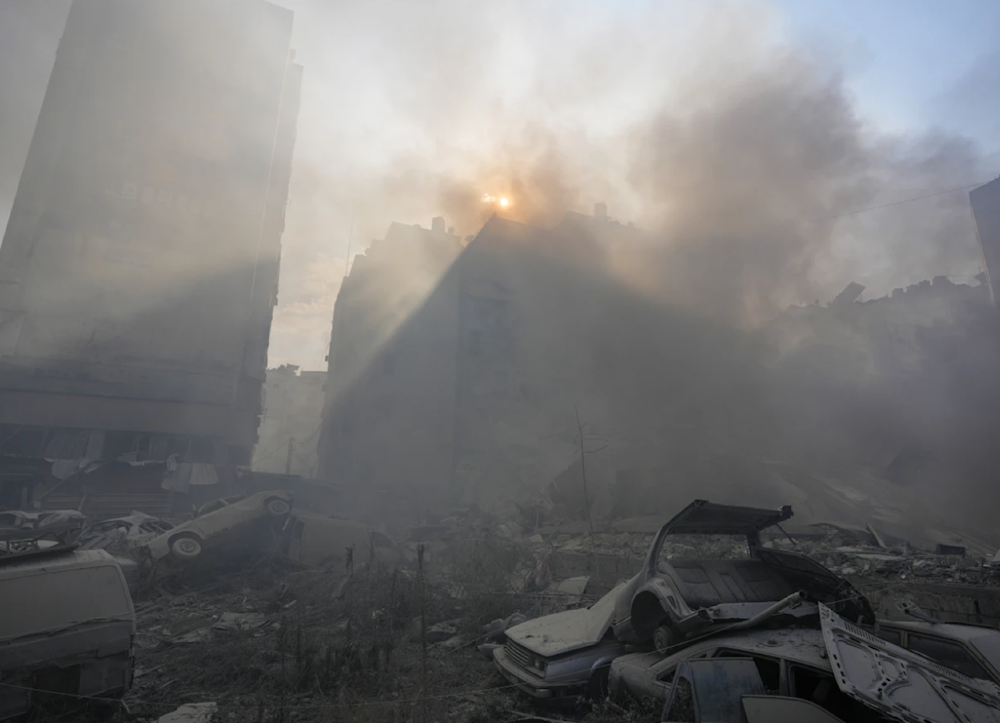Humanitarian situation in Lebanon worse than 2006 war, UN says
"Israel's" aggression on Lebanon has forced 1.2 million people into displacement and killed around 3,000 Lebanese civilians.
-

Smoke rises from the site of an Israeli strike in Dahieh, Lebanon, on November 1, 2024. (AP)
The current humanitarian situation in Lebanon due to Israeli aggression is worse than that in the 2006 July war on Lebanon, the United Nations Office for the Coordination of Humanitarian Affairs (OCHA) said on Saturday.
"The humanitarian situation in Lebanon has reached levels that exceed the severity" of the previous Israeli war on Lebanon in 2006, with many more people killed and displaced, OCHA reported.
According to the OCHA, the situation has deteriorated further as a result of "Israel's" forced evacuation orders for inhabitants of eastern Baalbek and southern Nabatieh.
The loss of essential infrastructure, particularly hospitals, has further compounded the disaster, according to the report.
Filippo Grandi, head of the UN refugee agency, UNHCR, stated in a social media post that humanitarian structures have also been targeted, as "even fleeing (and taking care of those who flee) are becoming difficult and dangerous as the war continues to spread."
The Lebanese government said 1.2 million people have been displaced, whereas the International Organization for Migration (IOM) believes that at least 842,648 individuals have been forced to evacuate their homes.
According to the International Committee of the Red Cross, the 33-day Israeli attack on Lebanon in 2006 killed 1,191 people and forced more than 900,000 people to flee their homes.
The declaration came as the Lebanese Health Ministry said the death toll from the current Israeli aggression on the country has risen to at least 2,968, while another 13,319 people have been wounded, the majority women and children.
This comes as UNIFIL headed to Wata al-Khaim in South Lebanon on Sunday to investigate the fate of 20 missing individuals, including women and children, amid the repeated incursions by the Israeli occupation forces into the area.
According to Al Mayadeen’s correspondent, residents of the southern town of al-Wazzani managed to retrieve the bodies of five martyrs out of the 20 missing in Wata al-Khiam.
UNIFIL, along with teams from the International Committee of the Red Cross (ICRC) and the Lebanese Red Cross, will work to recover the remaining bodies of the martyrs from under the rubble with the assistance of a heavy machinery.
50,000 Israeli troops fail to capture any Lebanese town: Israeli media
An Israeli newspaper reported that despite deploying over 50,000 troops in southern Lebanon, the Israeli military has yet to “capture even a single village.” Yedioth Ahronoth noted that after a month of operations involving five divisions—three times the force used in the 2006 war—"Israel" has failed to secure any foothold in the area.
According to the report, Hezbollah’s “effective tactical strategies” are a key factor, including layered defenses with precision munitions targeting Israeli armored vehicles and soldiers. The Israeli military has also struggled with mapping Hezbollah’s positions and neutralizing small, elusive drones.
Hezbollah recently announced that it has destroyed numerous Israeli vehicles since the ground invasion began, including 42 Merkava tanks, 4 bulldozers, 2 Hummers, an armored vehicle, and a troop carrier. The statement added that over 95 Israeli soldiers have been killed and 900 wounded, with three Hermes-450 and two Hermes-900 drones also downed.
Colonel Jack Neriya, a former advisor to Israeli occupation Prime Minister Yitzhak Rabin, commenting on Hezbollah’s tactics, explained that fighters are deliberately allowing Israeli occupation forces to advance before trapping them in ambushes, creating significant challenges for even elite units like Golani.
Neriya warned that this approach could lead to higher casualties for Israeli forces than in any war since the late 1940s.

 4 Min Read
4 Min Read








